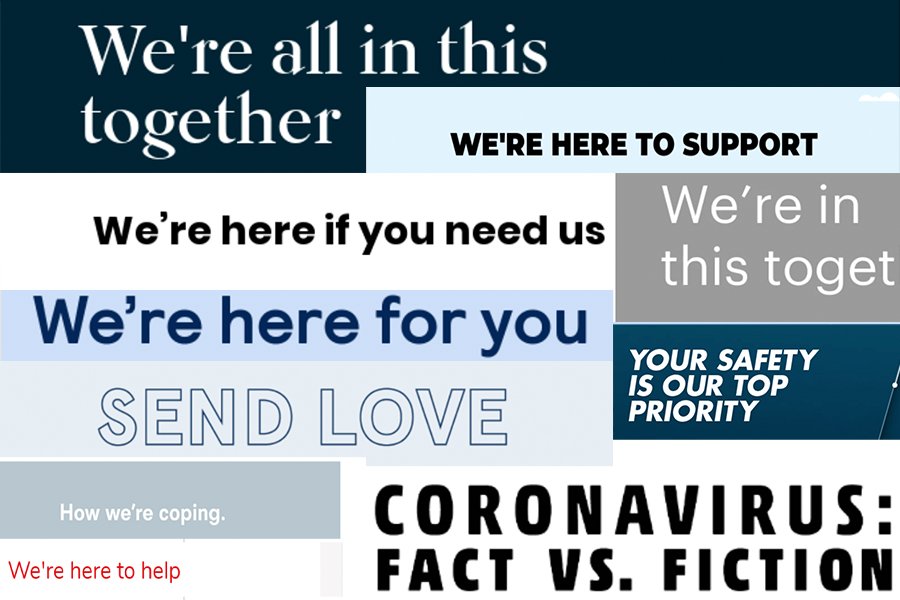Now that we’ve distanced ourselves from the rapid succession of “In these uncertain times,” “COVID-19 Update,” and “We’re Here For You” subject lines in our inboxes, let’s take this time to look back at how companies tackled email marketing (in) a crisis.
The Good
After your 50th email on the topic, it probably felt like all of the emails were unwelcome and bad, but there is actually a lot of good to be found. This will encompass a lot, but truly any email that made you feel anything ranging from neutral to good (whether through reassuring facts or distractions) gets a passing grade.
A study done by Morning Consult, a data intelligence company, found that what people really wanted from advertising during this time was: info on companies’ service adjustments/updates (44%), and info detailing how a company is helping during the pandemic (24%).
In our experience, we saw this delivered in multiple cases. A car mechanic reached out to its customers — not to let them know about the great discounts and deals they could take advantage of — but to offer their excess toilet paper (free of charge) and free grocery delivery service, along with contactless options for having a vehicle serviced.
We saw an airline send weekly updates on the state of air travel and how that company will be changing its operations to make traveling safer for everyone.
The same Morning Consult study, Weathering the Storm: Brand Management in COVD-19 Era, revealed that only 13% of Americans surveyed thought all advertising should stop. However, they do have a clear preference for how companies do that: It’s not about advertising to, it’s about communicating with.
In that realm, we saw the most good. We saw brands reaching out with tips, ideas, messages about how the brand intends to uphold its values. There have been messages from grocery stores reassuring that spring has not actually been canceled, and ways to embrace the season. Tips across the board for children and parents alike have encompassed how to move forward with a schedule no one expected to have. A brand entirely focused on home — renovating, restoring, and decorating — sent a message not focusing on consumers buying their products, but about creating a space for their community to share their experiences.
The Bad
Approaching this as both consumers and marketers, it’s a little tricky to point out some of faux pas. It’s important to consider that maybe some companies didn’t have the budget to dedicate to emergency communications. Maybe there were too many legal hoops to jump through to send a message expediently. There are plenty of reasons something could have gone wrong. Ultimately, these emails all came from people, and we believe in being human. No one and no brand is perfect.
But for the sake of trying to improve for the future, we submit a no-name-calling list of not-so-great emails:
- The email from a company you didn’t know had your info, or didn’t even know existed
- The automated “it’s time for your appointment” email, when there are no appointments to be made
- A slightly cringe-y ad for deals on diamonds (or anything absolutely nonessential) in these trying times
- Messaging throwing all CAN-SPAM guidance to the wind, and using “FREE” in subject lines and PHTs
- An email from your health insurance two weeks too late to be reassuring
To this list of bad messaging, we also include any email that played into what seemed like a universal script for businesses during tragedy: In these trying times, we’re here for you. As shown in the compilation below, when delivered en masse, the message loses its effect, and hints that businesses are only trying to tell us what they think we want to hear in order to keep our business.
And that brings us to…
The Insincere
The instinct for businesses to stick to their original business models and marketing strategies is strong. It’s got them where they are now after all.
But, consumers can detect a disingenuous rat, even if it has good intentions. From a 2015 article addressing the topic of insincerity in cause marketing, School CEO Max Lenderman said, “Brands have to be like verbs: There has to be visible action. But consumers today are sophisticated enough to see when love is being bought. You’re not making anyone ‘happy’ with soda water and diabetes — and consumers can see through that.”
Similarly, consumers can see that brands being “here for them” means nothing when they are not also offering actionable tips and content or meaningful savings on vital products and services during a crisis.
In the Wall Street Journal‘s examination of coronavirus marketing, Samantha Geloso, a copywriter in New York, said that marketers and agencies would do best if they focused on solving problems and left most of the messaging for another day, Ms. Geloso said.
“Now more than ever, to quote every commercial ever, you can actually stop emotionally manipulative montages and use your resources for good,” she said. “It can be even a small problem.”
To succeed as a company is to succeed with your consumers. And during disasters, pandemics, and tragedies companies have to be willing to make their messaging — and their values — focus on people behind the dollars.
At best, insincere messaging can be ignored. But at its worst, putting profits before people is how brands lose audiences forever.





